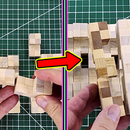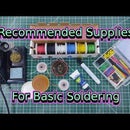Introduction: Desoldering | Soldering Basics
Sometimes when you're soldering, you just need to remove some parts. I'm going to show a few methods for removing parts that are soldered to a circuit board. For each of these methods the part you're trying to remove will heat up, so be careful.
If you're interested in learning about some other aspects of soldering, you can check out the other Instructables in my Soldering Basics Series:
- Using Solder (Click Here)
- Using Flux (Click Here)
- Soldering Wires to Wires (Click Here)
- Soldering Through Hole Components (Click Here)
- Soldering Surface Mount Components (Click Here)
- Desoldering (This one)
- Using Perfboard (Click Here)
I'm open to adding more topics to this series over time so if you have any suggestions, leave a comment and let me know. Also, if you have any tips to share, or if I get some of my info wrong, please let me know. I want to make sure this Instructable is as accurate and helpful as possible.
If you would like to see a video version of this Instructable, you can see that here: https://youtu.be/bG7yW9FigJA
Supplies
Step 1: Introducing: Desoldering Wick
For the first method of removing solder from the parts, I'll show you how to use desoldering wick. Sometimes it's also called solder wick, solder braid, or desoldering braid. It's basically just a braid of thin copper wires. The idea for how this works is that when the solder on the board melts, it soaks into the desoldering wick.
Step 2: Using Desoldering Wick
Put the desoldering wick on the solder, then use the soldering iron to heat it up. If the solder is not soaking into the wick, use some flux. My Instructable about Using Flux (Click Here) explains why this will help. Now when you heat the solder joint, the flux will do its thing with the solder, and also soak into the wick. As the solder melts, it will follow the flux off of the parts and into the wick.
Step 3: Introducing: Desoldering Pump
Now for the next method of removing solder, I'll use a desoldering pump. It has a plunger that you push down, then when you're ready for it to suck up the solder you press the button.
Step 4: Using a Desoldering Pump
Heat the solder directly with the soldering iron, with the tip of the desoldering pump nearby. The plastic tip is heat resistant so you can have it in direct contact with the soldering iron, and it shouldn't melt. Push down the plunger, melt the solder with your soldering iron, then with the tip of the desoldering pump next to the solder joint, press the button. Sometimes it takes a few tries but it works very well.
Step 5: After Removing Solder
For both of these methods of removing solder, they don't remove 100% of the solder so the part will probably still be stuck in place. In the pictures you can see that the leads are stuck to the sides of the holes. I've found that you can use your soldering iron to heat up the leads then push them loose. This helps to finish removing the part.
Step 6: Bonus Trick
Here's a trick that makes it very easy to remove the part, if the leads are close enough together. Instead of removing solder, add more. Add enough solder to connect both of the leads together. Now when you melt the solder it will melt on both of the leads at the same time and it will be easy to pull the part out. You may still need to remove some remaining solder from the holes, but you can use the methods that I've already described to do that.
Step 7: Don't Damage the Copper Pads
And finally, I need to discuss possible damage that could result if you're not careful. The copper pads that the parts are soldered to may peal off of the board. This can happen if too much heat is applied, if heat is appied for too long, or if the part is pulled off while the solder is still holding it. If the copper pad does come off, you can still replace the part but you will need to compensate for the missing copper pad.
Step 8: And That's It!
If you have any tips or advice that you would like to share for desoldering and removing parts from circuit boards, please leave a comment and share your ideas. Thank you for checking out this Instructable!
Here are the other Instructables for my Soldering Basics Series:













